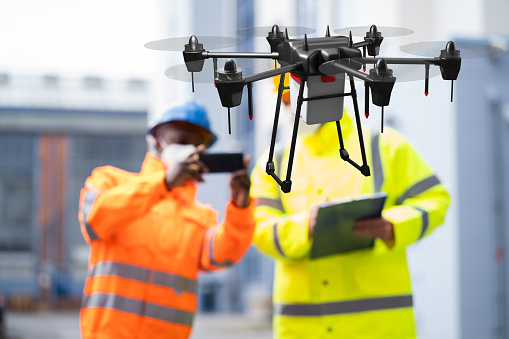Though 2020 and 2021 were challenging years for business because of the COVID-19 pandemic, the construction industry has recorded a significant recovery. The future of this industry globally looks promising and is expected to reach $10.5 trillion by 2023.
This is due to rising construction trends, the growing population, and increasing urbanization. The rising trends in the construction industry have a direct impact on the changing aspects of the industry.
To stay competitive and meet customer expectations, contractors must stay on top of the trends in the industry. Here are some of the industry trends that you should watch out for:
1. Efficient Technology
One of the biggest trends to expect in 2022 is the introduction of technology in construction. Especially innovations that can promote efficiency. Since the pandemic introduced the world to a more digital approach, people had to adapt to remote working and learning.
Several industries, including the construction industry, had to rely on technology to get work done. This trend will increase in popularity in 2022 and the future.
Some of the efficient technologies that will trend in the industry include:

Construction Drones
This is one of the fastest-growing trends in the construction industry. This technology offers more than just aerial videography or photography. Today, contractors can use drones to produce valuable aerial heat maps and thermal images and map large areas over long distances.
The drones can deliver data in real-time, which can help with fast decision-making. This will streamline the construction process. Drones can also help reduce theft on the site, minimize hiccups, keep projects on schedule, promote security, and more.

Smart Contracts
This technology can help improve relationships in the industry. Since it offers a more secure and fast approach to delivering and approving documents, it will help improve productivity. Smart contractors will also offer better project tracking, faster closeouts, automated supply chains, and increased security.

Building Information Modeling (BIM)
This construction digitalization technology is one of the best when it comes to improved efficiency. It allows the user to generate computer renderings of utilities and buildings. This makes it easy to manage the models and share data, as necessary. This also promotes accurate completion of projects.

Augmented Reality (AR)
The AR market is expected to reach more than $1.2 trillion by the end of the decade. This technology ensures efficient project staging. It also makes preconstruction projects tangible for buyers and tenants. AR promotes:
- Safety training
- Hazard simulations
- Fast and affordable simulation of structural and architectural changes
- Automated measuring of buildings
- 3D visualization of future projects
AR can also help avoid oversights that can increase the budget and lower the chances of reworking a project after commencement.
2. Construction Management Software
All-inclusive construction management software is an essential tool to have. This technology will promote operational efficiency, build valuable business, and help contractors remain competitive.
Though every software service is different, having the right software with the right features is a valuable asset. Some of the features that the software should have include:
- The ability to share files with mobile teams
- Payroll and HR
- Budgeting
- Inventory monitoring
- Document Control and storage
- Accounting
- Project management
- Time tracking
- Tool tracking
The right software will allow easy integration. It should be scalable, customizable, and easy to upgrade. It is also ideal to have CRM software and integrate it with your construction management software.
3. Mobile Access and Remote Worksites
The introduction of mobile apps in the construction industry will make it easy to access worksites like never before. It will also promote accurate measurements, on-site accountability, and real-time inspections.
With remote worksites, on-site workers will be able to share project details more accurately and easily. This technology promotes digital transformation and will also allow virtual meetings and increase productivity.
4. Increased Safety
Safety measures such as sanitization, keeping distance, and other measures introduced by the COVID-19 pandemic significantly affected the construction industry. Contractors and site managers had to update site regulations and adhere to the new safety standards.
This increases construction time and costs for projects. Additionally, the industry is also seeing the rise of machines, which can identify common safety issues and eliminate them. Today, there are wearable innovations such as work boots with Wi-Fi connections that are making their way to construction sites.
Such boots can send alerts if the wearer has fallen. There are also robots that can lay bricks or construct scaffolding and material moving mules that can transport hazardous or heavy items.
Apart from work gear and robots, the industry is also relying on 3D printing. This decreases transportation risks. Also, there are sensors that detect wind, heat, and noise in construction sites and give alerts to allow quick evacuation and allow workers to move costly equipment.
5. Green Construction
One of the construction industry trends for 2022 that you should watch out for is green building. Several residential and commercial renters and homebuyers are going green. However, the most eco-friendly and sustainable features in the construction industry are still a luxury.
Nevertheless, with the renewable energy source at 11% of the energy market in 2019, you can expect shares and accessibility to grow. Green construction will help lower a building’s carbon footprint and reduce the use of resources.
Additionally, a greener building will have more value and a positive physiological and psychological impact on its occupants.
6. Rising Need for Laborers
The rising demand influences the need for more construction workers and the demand for skilled labor in the construction industry. Quality labor is competitive and costly. Even though robots today are picking up the slack, the industry still relies on the workforce and human skills.
Contractors require educated and trained workers to do manual work, manage projects, and interpret data. Today, several women are also stepping in to fill such competitive roles.
The industry is also targeting Generation Z, who are more familiar with digitalization and technology, to allow them to experiment with the new digital trends. Such laborers will help the company update its technology and keep up with the rising trends.
7. Smart Cities
Most big tech companies like Cisco, Microsoft, and IBM are investing so much in megaprojects to construct sustainable and smart cities. Such cities are more complex than other huge projects.
Smart cities require a lot of rigorous planning and development before construction. Some global megaprojects include:
- The Hudson Yards in New York City
- Masdar City in the United Arab Emirates
- Songdo International Business District in South Korea
- India’s Delhi-Mumbai Industrial Corridor.
Such projects cost over $100 billion and will have a positive impact on the economy. These trends are changing the global construction market, leveraging technology, and creating more opportunities for skilled workers.
8. Focus on Residential Projects
As big tech companies are putting more effort into promoting the increase of megaprojects, some construction companies are no longer pursuing public projects. Instead, they are focusing more on residential projects.
Residential projects have lower risks and are expected to increase by at least 7% in 2022. With the residential market increasing, competition is also expected to increase. Therefore, it is crucial to remain trendy and visible.
9. Modular Construction
This construction trend involves producing modules of a building in the factory and transporting the modules to the job site. The modular construction market is common in residential construction and is expected to increase in value to $110 billion by 2025.
This type of construction reduces costs and cuts construction timelines. Several companies are already taking advantage of modular construction. This technology also requires skilled labor.
Modular projects also offer contractors the ability to regulate safety and control the work environment. This makes it ideal for projects in COVID-19 high-risk areas because it is easy to maintain social distancing with modular projects.
10. Rising Costs of Materials
The Producer Price Index for construction goods increased by 17% in 2021. This is according to the United States Bureau of Labor Statistics. The growth in the interest rates is likely to include all types of costs and this will also affect the construction project.
Some of the innovative materials that will help lower costs include:
- Invisible solar cells
- Transparent aluminum
- Light-generating concrete
- Self-healing concrete
- 3D graphene
Different technologies such as BIM, AR, and drones will play a significant role in combating the pressure on the cost of projects and the volume of work. Innovative technology and living materials may also help lower the costs.

Get Ready for the New Era Construction Trends
The construction industry is welcoming the latest trends and adapting technology in various aspects of the industry. These construction trends will change the industry for the better. With these changes to the industry, they are bringing construction into a future with safer working conditions, modernized tools and buildings, and more sustainable projects even beyond 2022.
If you are looking for the right software and digital tools to transform your business, Bangert has solutions you can count on. With over 38 years in the industry, our experts understand the ever-evolving changes that people in construction face.
Contact us to learn more about digitizing your company!
